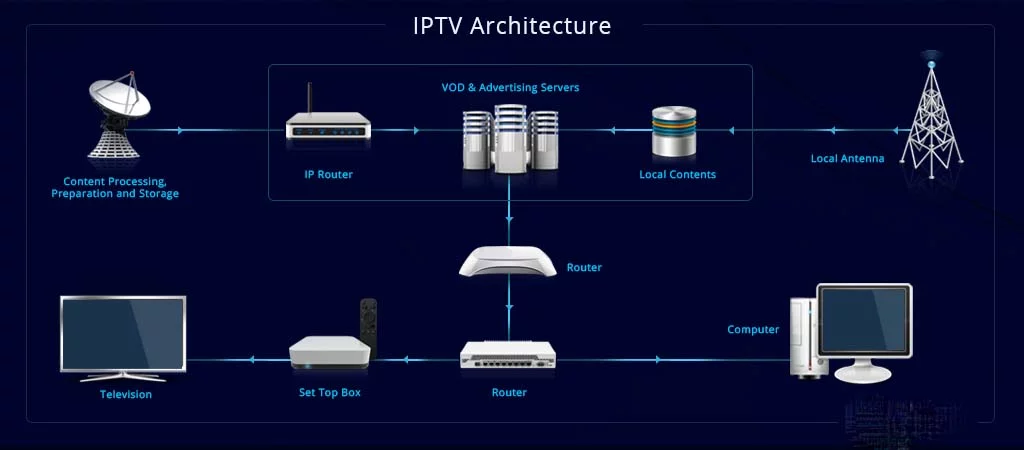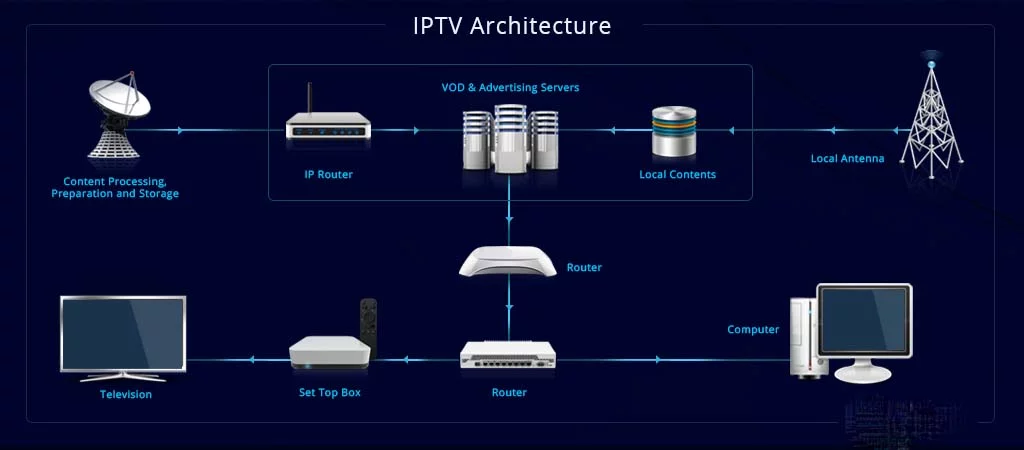Are you eager to uncover the intricacies of IPTV? In the realm of online streaming, a paradigm shift has commenced, ushering in a new era where traditional modes of broadcasting, such as cable and satellite TV, are making way for internet-based streaming. In this evolving landscape, takes center stage, playing a pivotal role in the transition.

For the modern viewer, content ownership takes a back seat to content accessibility, and this is precisely where IPTV steps in.
Let’s delve into the enigmatic world of IPTV, exploring its workings, architecture, the array of services it offers, and the promising future it heralds.
Unveiling IPTV
IPTV, an abbreviation for Internet-based Protocol Television, utilizes the internet as the conduit for delivering TV programs and videos, whether they are live broadcasts or on-demand content. This innovative system employs Internet protocol technology and leverages broadband or internet connections to provide digital television services to subscribers.

Diverging from the realm of digital video, which caters to the masses through platforms like YouTube and Netflix, sets itself apart with its unique, pervasive nature. Furthermore, it offers the convenience of allowing multiple TV sets to access content through a single subscription within a household.
With an IPTV subscription, viewers gain the added advantage of selecting the content they wish to watch at their own convenience, in addition to tuning into live TV shows currently being broadcast.
To grasp how distinguishes itself from traditional TV, it’s imperative to draw a comparison:
Cable and satellite TV operate by allowing users to “tune in” to specific channels within their signal. Cable relies on a wired connection, while satellite employs wireless technology until it reaches the recipient’s premises. For instance, Time Warner Cable employs coaxial cable connections, whereas providers like DirecTV transmit content via radio waves.
In contrast, IPTV utilizes an Internet protocol (IP)-based network to deliver TV channels to users through set-top boxes. This network operates under the same client-server model that powers email and websites, making it distinct from cable and satellite TV. IP, or Internet Protocol, serves as the language for transferring data packets among computers connected to the internet network.
Rather than broadcasting content in real-time, as with cable and satellite, IPTV servers can store programming on their end, allowing users to request content over the internet whenever they desire.
Demystifying the Mechanism IPTV operates more akin to web browsing than traditional channel surfing. It leverages Internet Protocol (IP) as a delivery mechanism to transmit videos to viewers. When a viewer selects a TV program or requests a video, data packets from various sources (servers) are divided and dispatched over the internet. Video servers employ fiber-optic cables to transmit programs to households via internet connections, and users can initiate requests to receive the desired content.
To gain a deeper understanding of how IPTV functions, let’s explore its architectural framework.
The Architecture of IPTV Depending on the network architecture, IPTV can be deployed in two primary models: centralized and distributed.
In the centralized model, all media content resides on centralized servers, making it a manageable solution that doesn’t necessitate an extensive content distribution system. This architecture suits networks with small-scale Video on Demand (VOD) service deployments, adequate core and edge bandwidth, and an efficient content delivery network (CDN).
Conversely, the distributed model offers scalability along with bandwidth efficiency and inherent system management features, crucial for larger server networks. For operators planning substantial systems, adopting a distributed architecture from the outset is prudent. This approach requires sophisticated content distribution technologies to ensure the effective delivery of multimedia content over the service provider’s network.
An illustrative diagram of a typical IPTV network architecture includes:
- Central Unit: This unit receives broadcast content from satellites and local antennas. It encodes, encrypts, and delivers live TV channels and AV sources as IP multicast streams. The central unit also encompasses Advertising Servers, Live TV Streaming Servers, Video on Demand (VOD) servers, and the platform where on-demand video assets are stored and served as IP unicast streams upon user requests.
- Delivery Network: To provide a robust internet uplink, fiber optics transmit content from the IPTV broadcaster to the viewers’ premises.
- Set Top Box (STB): Viewers who subscribe to an IPTV service receive a specific STB. This endpoint equipment decodes and decrypts TV and VOD streams for display on the TV screen. The STB connects to the viewer’s internet connection (router), enabling the delivery of video and TV content.
- Interactive Portal: Viewers interact with the IPTV service through an interactive portal on the STB. This interface allows users to navigate through different IPTV services, including the VOD catalog.
While variations in IPTV architecture may exist among different service providers, the core principles remain consistent, as exemplified here.
Diverse IPTV Services IPTV not only transmits traditional TV channels but also offers a range of interactive services:
- Video on Demand (VoD): This service allows individual delivery of video content to subscribers. Users can select and watch movies from the VoD server’s media library.
- Near Video on Demand (nVoD): nVoD is a pay-per-view video service designed for multiple subscribers. Content broadcasting schedules are prearranged, enabling viewers to watch content based on their preferences.
- Time-shifted TV: This feature permits subscribers to view live broadcasts later, providing the option to playback and resume at their convenience, including rewind capabilities for TV programs.
- TV on Demand (TVoD): Selected TV channels are recorded and can be viewed at the viewer’s convenience.
- Live Television: Live TV shows can be watched with or without added interactivity.
The Present and Future of IPTV IPTV has witnessed consistent growth in recent years, with over 130 million IPTV subscribers worldwide. The surge in subscribers, boosted by markets like China, has been significant. Europe and Asia lead in the number of subscribers, while Europe and North America contribute a larger share of global revenue due to low average revenue per user (ARPU) in regions like China and India. The Asian market, with its rapid growth, is poised to become a major player.
Market predictions reflect the promising future of IPTV. Reports anticipate the global IPTV market will grow significantly, reaching around USD 93.59 billion by 2021. This growth trajectory is driven by an increasing consumer base and expanding service offerings.
IPTV’s rise will notably impact cable services, while satellite services are expected to remain robust. Additionally, IPTV networks have expanded to countries across the globe, aligning with the growing demand for this innovative technology.
While global players continue to propel IPTV’s growth, a shift towards Over-the-Top (OTT) and Subscription Video on Demand (SVOD) services like Netflix and Hulu is discernible. As part of an ongoing trend, viewing habits are gradually transitioning toward these alternatives.
In conclusion, this overview offers insight into what IPTV is, how it operates, and its current state and future prospects. Should you be interested in launching your own OTT streaming service, Muvi provides an end-to-end solution encompassing IT infrastructure, Content Delivery Network (CDN), Online Video Platform, Digital Rights Management (DRM), Player, Content Management System (CMS), monetization options, and Payment Gateway integration, all deployable with ease, requiring no coding or extensive IT resources. Get started with your Multi-Screen OTT Service today!


